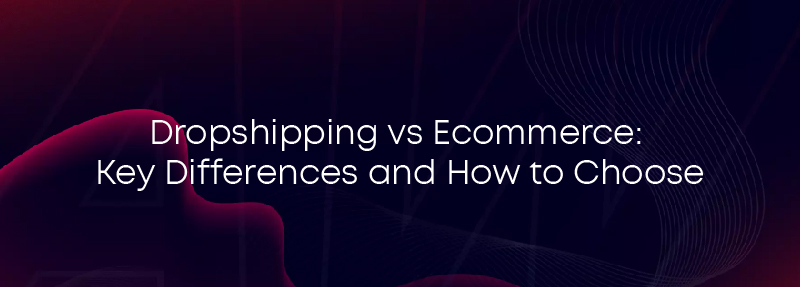
The online business journey has been an exceptional journey for many entrepreneurs in the past few years. Ever since two of the popular business models that have found their places in the e-commerce market are dropshipping and ecommerce, each of the two has its own advantages and disadvantages, attributes, and challenges. The worldwide cumulative figure of digital shoppers grew by over one billion between 2019 and 2023 and is going to continue to grow.
Many entrepreneurs are wondering which model is best. To make things simple for you, we will discuss all the details you need to know in this comprehensive blog.
Dropshipping
When a merchant is into dropshipping, he does not keep stock of goods with him. So, whenever a customer orders to buy a product, the merchant gets that specific product from a third-party supplier, and that third-party supplier ships it directly to the customer.
How It Works
In a typical dropshipping setup:
• You select a product niche and find reliable suppliers (e.g., AliExpress, Spocket).
• Customers place orders on your online store.
• You forward these orders to the supplier, who fulfills and ships them.
Key Benefits
1. Low Upfront Costs: No need to purchase inventory, reducing initial investment.
2. Flexibility: Operate from anywhere with an internet connection.
3. Minimal Risk: No unsold inventory means lower financial exposure.
Challenges
1. Limited Control: Reliance on suppliers for product quality and delivery timelines.
2. Lower Profit Margins: Since suppliers handle fulfillment, profit margins are typically slimmer.
3. High Competition: Popular niches are often saturated, making it harder to stand out.
Ecommerce
E-commerce is the traditional form of online shopping where businesses control the inventory and fulfillment functions to manage customers end-to-end through it.
How It Works
In an ecommerce setup:
• Businesses purchase inventory upfront and store it in a warehouse or dedicated space.
• Customers order products through an online platform.
• The business fulfills these orders directly, ensuring quality and timely delivery.
Key Benefits
1. Full Control: From inventory management to shipping, you control every aspect of the business.
2. Branding Opportunities: Custom packaging and branding options enhance customer experience.
3. Higher Profit Margins: Direct control over pricing often leads to better profits.
Challenges
1. Higher Upfront Costs: Buying and storing inventory requires significant investment.
2. Inventory Risk: Unsold products can lead to financial losses.
3. Operational Complexity: Managing storage, shipping, and returns can be time-intensive.
Key Differences
The key differences between dropshipping and e-commerce are:
Business Model
In the dropshipping business model, the merchants don’t keep the inventory and buy it from the third-party supplier who further makes the shipment. Whereas in e-commerce, the entrepreneur owns and manages the inventory and has full control over the functions and operations.
Startup Costs
Dropshipping requires capital investment. The cost of starting a dropshipping business may range between $250 and $500. In contrast, an e-commerce business costs around a grand for inventory and storage.
Scalability
The scaling of dropshipping can become a much easier process since fulfillment can be handled by suppliers. Although the scaling of e-commerce appears to be quite rewarding, it involves investments in warehousing, staff, and even logistics.
Profit Margins
In dropshipping, margins typically range between 10% and 30%, whereas an e-commerce company can take from 40% to 70% margins because of suitable pricing and buying in bulk.
Time and Effort
Suppliers handle storage and shipping, making dropshipping less time-intensive. Ecommerce has a lot of efforts in inventory handling, fulfilling, and customer service.
Risk Level
Quality control and delays are some of the big challenges in dropshipping because of the dependency they have on suppliers. The most significant risk in an e-commerce business is unsold inventory, as it locks the capital.
How to Choose the Right Model for Your Business
These steps will help you choose the right business model:
Assess Your Goals
Drop Shipping is ideal for those who want to test the ground low-risk in online selling. It’s a great way of ecommerce for a budding entrepreneur planning to build a scalable and niche-oriented business.
Evaluate Your Budget
Drop shipping is the best thing for those who are living on a very tight budget because it involves lower upfront costs, while greater long-term profitability would be involved in using e-commerce with more money available to invest in it.
Consider Your Skills
Do you have a knack for customer service, marketing, or logistics? Marketing capabilities will determine how successful your dropshipping business becomes, while e-commerce is an operation and branding game.
Research Your Niche
Some niches are more popular than others because they have greater demand and lower entry barriers in dropshipping. For instance, going online with various research tools like Google Trends or SEMrush could help find such a bargain.
Test and Adapt
Try to test the models on a small scale. Shopify and WooCommerce are other dropshipping-supported e-commerce platforms that pivot based on performance.
When to Choose Dropshipping
It seems to be a great business for aspiring entrepreneurs who want a low-risk entry into e-commerce. Dropshipping may be considered in these cases:
• Limited Initial Capital
• Desire for Operational Simplicity
• Testing New Products or Markets
• Flexibility and Mobility
• Focus on Niche Markets
• Scalability Without Infrastructure Investment
When to Choose Ecommerce
Opting for a traditional ecommerce model is advantageous in the following situations:
• Desire for Brand Control
• Higher Profit Margins.
• Enhanced Customer Experience
• Customization and Product Differentiation
• Preparedness for Operational Complexity
• Long-Term Business Vision
Conclusion
Ultimately, both of these business models, dropshipping and e-commerce, have their own unique offerings with regard to online business. Entrepreneurs preferring a low-risk, flexible route would choose dropshipping. However, e-commerce requires a long-term strategy with the necessary control features.
The final decision of model choice depends upon your goals, budget, and skills to align with your aspirations. Ready to start your online business? Explore your options with American Web Builders, leverage tools, and get on your entrepreneurial journey today!
Ready to Elevate Your Brand?
Create a powerful brand identity and
web design that reflects your aspirations.
Fuel Your Brand’s
Prosperity with
Captivating Logo Designs
Explore the full spectrum of innovative design. Our specialists
are dedicated to transforming your brand from a memorable
logo and an intuitive web design to professional
stationery, seamless e-commerce integration, and a
cutting-edge mobile application.
We Are Here To Help
Skyrocket Your
Business’s Meteoric
Rise with the Experts
Launch your company into the stratosphere! American Logo
Developers’ skilled staff is here to help propel your brand.
Take a chance and shoot
for the moon today.
Providing Industries with Innovative,
Tailored Solutions to Transform Success Across USA & Canada
- Arlington
- Cleveland
- Jacksonville
- Miami
- Orlando
- Atlanta
- Dallas
- Louisville
- Minneapolis
- Philadelphia
- Austin
- Denver
- Kansas City
- New York
- Portland
- Chicago
- Houston
- Los Angeles
- New Orleans
- San Diego




























